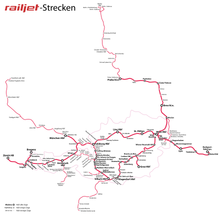Austrian Federal Railways
The Austrian Federal Railways and formerly the Bundesbahnen Österreich or BBÖ), now commonly known as ÖBB, is the national railway company of Austria. It also runs Liechtenstein's railway. The ÖBB group is owned entirely by the Republic of Austria. It is divided into several separate businesses that manage the infrastructure and operate passenger and cargo services.
 | |
| Company type | Aktiengesellschaft |
|---|---|
| Industry | Transport |
| Predecessor | Erste Eisenbahnwagen-Leihgesellschaft |
| Headquarters | ÖBB Unternehmenszentrale, , |
Area served | Central Europe |
Key people | Andreas Matthä |
| Products | Rail transport, Cargo transport, Services |
| Total assets | |
| Total equity | |
| Owner | Republic of Austria |
Number of employees | |
| Divisions |
|
| Website | www.oebb.at |
| Footnotes / references [1] | |
















The Austrian Federal Railways was first formed in 1923, using the Bundesbahn Österreich name, as a successor to the Imperial Royal Austrian State Railways. It was incorporated into the Deutsche Reichsbahn during the 1938–1945 Anschluss. It was reformed in 1947, under the slightly different name Österreichische Bundesbahnen, and still uses this name.
The Austrian rail system is mostly electrified. Electrification began in 1912 but did not reach an advanced state until the 1950s. The last steam locomotive in regular service on the standard gauge network was retired in 1978.
Major changes currently being made to the Austrian railway network are the construction of the Koralm Railway, the Semmering Base Tunnel and the Brenner Base Tunnel connection with Italy.
Eurobarometer surveys conducted in 2018 showed that satisfaction levels of Austrian rail passengers are among the highest in the European Union when it comes to punctuality, reliability and frequency of trains.[2] Furthermore, with their Nightjet brand, ÖBB operates Europe's largest night train fleet.[3]
Unlike other major railway companies in Europe that offer more flexible cancellation policies, ÖBB only offers two types of tickets: full-price tickets, and cheaper but non-exchangeable and non-refundable tickets.
References
change- ↑ "Geschäftsbericht 2019 (annual report 2019)" (PDF). presse.oebb.at/en/. Alphabet Inc. Retrieved June 17, 2020.
- ↑ "Mobility and transport" (PDF).
- ↑ "Austrian Federal Railways Orders Additional Night Trains from Siemens". 10 August 2021.